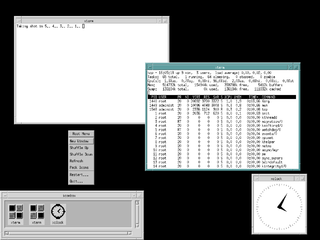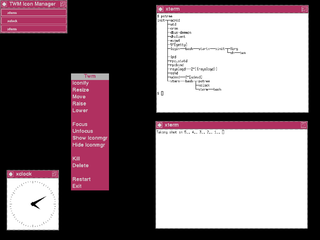
The Common Desktop Environment (CDE) is a desktop environment for Unix and OpenVMS, based on the Motif widget toolkit. It was part of the UNIX 98 Workstation Product Standard, and was for a long time the Unix desktop associated with commercial Unix workstations. It helped to influence early implementations of successor projects such as KDE and GNOME, which largely replaced CDE following the turn of the century.

The X Window System is a windowing system for bitmap displays, common on Unix-like operating systems.

In computing, Motif refers to both a graphical user interface (GUI) specification and the widget toolkit for building applications that follow that specification under the X Window System on Unix and Unix-like operating systems. The Motif look and feel is distinguished by its use of rudimentary square and chiseled three-dimensional effects for its various user interface elements.
Presentation Manager (PM) is the graphical user interface (GUI) that IBM and Microsoft introduced in version 1.1 of their operating system OS/2 in late 1988.

OPEN LOOK is a graphical user interface (GUI) specification for UNIX workstations. It was originally defined in the late 1980s by Sun Microsystems and AT&T Corporation.

twm is a window manager for the X Window System. Started in 1987 by Tom LaStrange, it has been the standard window manager for the X Window System since version X11R4. The name originally stood for Tom's Window Manager, but the software was renamed Tab Window Manager by the X Consortium when they adopted it in 1989. twm is a stacking window manager that provides title bars, shaped windows and icon management. It is highly configurable and extensible.

A stacking window manager is a window manager that draws and allows windows to overlap, without using a compositing algorithm. All window managers that allow the overlapping of windows but are not compositing window managers are considered stacking window managers, although it is possible that not all use exactly the same methods. Other window managers that are not considered stacking window managers are those that do not allow the overlapping of windows, which are called tiling window managers.

LessTif is a defunct free software reimplementation or clone of the Motif computer programming toolkit. The project aimed for full source- and binary-code compatibility with Motif. While this was not achieved, many Motif applications could run with LessTif or be compiled with it.
In computing, the X Window System is a network-transparent windowing system for bitmap displays. This article details the protocols and technical structure of X11.

X Toolkit Intrinsics is a library that implements an API to facilitate the development of programs with a graphical user interface (GUI) for the X Window System. It can be used in the C language. Design took place late 1980s to early 1990s.

OpenWindows is a discontinued desktop environment for Sun Microsystems workstations which combined a display server supporting the X Window System protocol, the XView and OLIT toolkits, the OPEN LOOK Window Manager (olwm), and the DeskSet productivity tools; earlier versions of OpenWindows also supported the NeWS protocol. It implements the OPEN LOOK GUI specification.

In computing, a virtual desktop is a term used with respect to user interfaces, usually within the WIMP paradigm, to describe ways in which the virtual space of a computer's desktop environment is expanded beyond the physical limits of the screen's display area through the use of software. This compensates limits of the desktop area and is helpful in reducing clutter of running graphical applications.

In the X Window System, a window is the region of the screen where drawing can occur. The root window covers the entire screen surface. Every window created is contained within it, forming a hierarchy with the root window at the very top. All other windows are either children or descendants of it.

In computing, the Ardent Window Manager (awm) is an early window manager software for the X Window System. It was descended from uwm.
The Windows Imaging Format (WIM) is a file-based disk image format. It was developed by Microsoft to help deploy Windows Vista and subsequent versions of the Windows operating system family, as well as Windows Fundamentals for Legacy PCs.
tvtwm is an X window manager derived from twm to which it adds the virtual desktop feature from swm. All of these window managers were originally written by Tom LaStrange. The current maintainer of tvtwm is Chris Ross. James Tanis believes he may be the only remaining user of tvtwm, and placed a notice on his web site seeking other users who would like a bug fix release.

In computing, the Motif Window Manager (MWM) is an X window manager based on the Motif toolkit.

Vtwm is an X window manager that was developed from the twm codebase. The first release was in 1990, and it is very much an "old school" window manager, lacking desktop environment features. It added features like xpm icons, autoraising of windows, and a virtual desktop; the latter feature is from where the program takes its name. Later additions include playing sounds in response to window manager events, and Motif-style window decorations in place of the "flat," 2D titlebars commonly associated with twm.

antiX is a Linux distribution, originally based on MEPIS, which itself is based on the Debian stable distribution. antiX initially replaced the MEPIS KDE desktop environment with the Fluxbox and IceWM window managers, making it suitable for older, less powerful x86-based systems. Unlike Debian, antiX does not use the systemd init system, instead, antiX provides images in which either SysVinit or Runit are set as the default init system.













